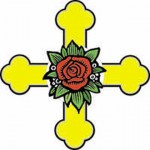Symbols of the Rosicrucian Order
Throughout the Rosicrucian Order, there are a number of symbols that are seen. Each of these has a historic and inherent meaning to the members of this order, representing the roots of the order. The full understanding of these symbols are only known by actual members, however there are some historians that have drawn conclusions for the meaning and use of various symbols within the Rosicrucian Order.

Rosicrucian Rosy Cross
One of the most well-known symbols of the Rosicrucian Order is the Rosy Cross. There is no religious connotation that is associated with this symbol and it is one that actually predates Christianity. The cross is a symbolic representation of the human body and the rose serves as a representation for a person’s unfolding consciousness, which is the underlying purpose of the entire Rosicrucian Order. When seen together, the cross and rose provide a representation of the challenges and experiences that each person sees during a thoughtful life that is well-lived.
Visiting a Rosicrucian Temple, you will see the use of a white and red rosebush hedge around the gardens in front of their temples, all around the world. This is a universal symbol that can be seen no matter what temple is visited, or where it is located. The petals of these roses are placed as a motif on the tops of the Boaz and the Jachin pillars in a reference to the Temple of Soloman.
Another symbol that is commonly seen in the Rosicrucian Order is the ten tree of life symbols, the Sephiroth, which can be seen on the façade of each temple, as well as in the garden surrounding the temple.
The fact is that the symbols used in Rosicrucian motifs is closely related to that of Masonic Orders, which suggests a connections of the societies, however this is only a historical assumption that has not been verified by the actual members of either organization.
The symbols that are known as part of the Rosicrucian Order are those that are seen on the outer portion of modern temples, and that historians have gathered over the years.